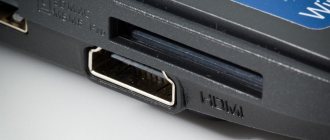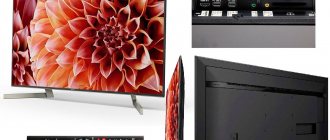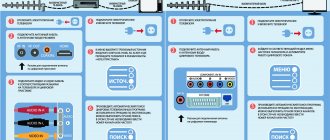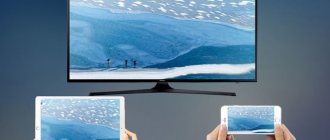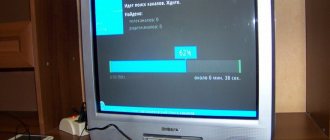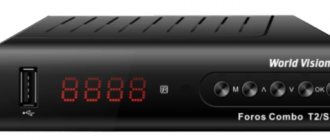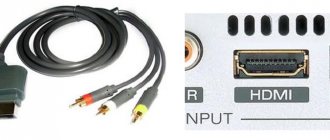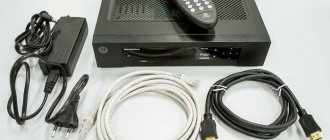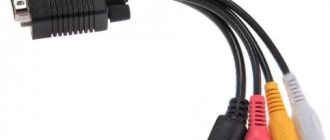A home video surveillance system has gone from being an exotic option to an effective way to protect your home from attacks by intruders and to keep abreast of events that occurred in the absence of the owners of the house. But to protect yourself, it is not enough to simply buy equipment and attach the camera to a safe place; it is important to connect the video camera to the TV correctly.
Selecting a camera or video surveillance system
There are several types of video surveillance systems on sale, each with its own characteristics:
Analog
The cheapest models that can be connected to any modern TV or monitor. The analog signal is not very detailed, so it is unlikely that you will be able to see small details that are important in some situations.
IP cameras
Network equipment with digital signal recording. There are models of IP cameras not only with a wired connection, but also transmitting a signal via Wi-Fi, which is suitable for organizing street video surveillance. TVI, HDCVI, AHD
Advanced models that replace analog cameras, offering detailed images, which can also be connected via analog inputs.
IP camera.
Sony Bravia
Sony Bravia TVs are correspondingly popular due to the fact that, unlike many other devices, they have an affordable price. At the same time, the technical characteristics and functionality of these devices remain at a high level.
Sony Bravias are not characterized by any distinctive features in terms of connecting such external devices to them. This process should be carried out in relation to Samsung Smart TV or LG Smart TV.
General connection diagram to Sony Bravia:
Thus, the general connection scheme to Sony Bravia is no different from connecting the same devices to Samsung Smart TV or LG Smart TV. The main thing is to carefully follow the instructions for use and the recommendations of people who have experience and skills in this.
Source
What you need to connect
To watch video from a camera in a recording online, you should prepare the following for connection:
- power supply with a cord long enough to connect to an outlet;
- suitable communication cable (additional adapters if necessary).
In order for the camera to operate continuously, it requires power. As a rule, a rectified, stabilized voltage of 9-15 volts with a current strength of 0.7-1A is required. Each model has its own power requirements; when connecting to a single power supply, the increasing load must be taken into account.
To connect a video surveillance camera to a TV directly, you need one of five types of cable:
- tulip;
- coaxial;
- HDMI;
- "Crab";
- S-Video.
Coaxial cable.
A popular cable is AV RCA, which allows you to connect the system through a tulip.
The most advanced solution is the use of HDMI, which is capable of transmitting signals in FullHD format and higher.
Samsung Smart TV
The process of connecting to Samsung Smart TV is almost the same as for LG Smart TV. This is due to their similar technology and some other features.
In order to connect an external device for shooting video to the TV, you need to perform the following list of actions:
After completing these steps, the TV owner can make video calls, take photos, or shoot home videos. There are no restrictions in this regard.
Device connection diagram
The connection procedure depends on the selected cable. In general, the scheme looks like this:
- connect the camera to a standard power supply;
- connect the TV to the camera with a suitable cable;
- launch the camera;
- on the remote control, press Source;
- select the signal source where the video camera is connected.
If the connection is correct, a live image or equipment settings menu will appear on the screen.
If your TV or camera does not have ports of the required format, use an adapter. At the same time, not all adapters are able to maintain the original quality of the broadcast signal, for example, when using the HDMI-AV connector.
When there is a need to create an archive of recordings, you can connect an external drive to the camera where information will be recorded. As a rule, this is a HDD disk or a MicroSD card. To prevent data from being erased over a long period of time, choose high-capacity drives.
How to connect an IP camera to a TV?
There are various situations that may require connecting a CCTV camera to your TV. And the most important reason is the organization of convenient work. When a video surveillance system is installed in the house, you need to constantly turn the computer on and off every time strangers come. And this is not entirely convenient. If the image is broadcast to the TV, then you only need to press a couple of buttons on the remote control.
There are several other reasons to synchronize your TV with an IP camera:
Procedure
Often, not only external video surveillance is connected to the TV, but also web cameras and systems for monitoring what is happening inside the apartment. In the first case, if there is a Smart TV, the panel turns into a multimedia center with the ability to video communicate with loved ones, record video blogs, stream broadcasts, and games. To use an analog card, you will need a serial connection through a personal computer that has a tulip-type input.
Direct connection is only possible with a camera that has an Ethernet card. Such cameras have high detail, a built-in microphone, and special effects can be added to the video sequence. Before connecting, make sure:
- the TV has the necessary connector that supports a digital interface;
- A cable is available for connecting devices into a single system.
To successfully start the system:
- connect Ethernet to the input;
- set up an Internet connection using the instructions;
- open the application;
- select the signal source.
To organize collective video surveillance, in order to save money, you can not buy several new cameras, but use one, together with a signal modulator. The diagram for such a connection will look like this:
- a break is made in the television cable where the modulator will be installed. It is fashionable to make a point both within the apartment and on the staircase;
- the modulator adds an additional channel with a free frequency to the stream, allowing the broadcast to be divided;
- Next, set your preferred broadcast frequency.
Using a signal divider you can display the image on four different TVs.
For old cameras that need to be connected to a new TV, you will need to purchase a special converter that converts the format of the transmitted signal. The system is created using a coaxial cable, which is crimped on both sides with BNC connectors. One side is output to the output located on the camera, and the other is installed in the “Input” socket on the converter, which in turn is connected to the TV panel using a VGA cable.
Checking with a tester
The easiest way to check the functionality of a rear view camera for a car is with a tester. First, the current consumed from the power source is estimated. Its value, depending on the resolution of the device, ranges from 50 to 200 mA. A more accurate value of this value can be found in the technical data sheet. The tester or multimeter is connected to the positive wire of the camera. If the current consumption is different from the norm, then the device is faulty.
Using a tester, you can measure the level (span) of the video signal at the device output. To do this, it is necessary that the measuring device has a high input impedance and can operate in a frequency band up to 50 MHz. One of the tester probes is connected to the central contact of the video connector, and the other to the side contact. The nominal level at the output of the composite video signal for a working device is 1 V.
Transfer images from multiple cameras to TV
If there is a need to display images from several cameras on the TV screen, you will need to use a more complex connection system. To do this, you will additionally need several DVRs and a media server where the signal will flow. The equipment is capable of transmitting a digital signal to several devices, and if Wi-fi is available, you can watch the video not only on a TV or desktop monitor, but also on a tablet or mobile phone. There is no need to lay wires indoors.
You can set up a broadcast via a server from several cameras, for example, when organizing a street video surveillance system:
- connect the TV to the server via an HDMI cable;
- install the software provided by the video equipment manufacturer on the media server (usually the application can be downloaded on the Internet);
- Using the program, set up signal transmission from the video camera to the server.
Further control of the software is performed from the remote control of the TV or set-top box. The signal will be broadcast on the HDMI channel; you can switch to it in the “Signal Source” section.
You can transmit images from several cameras simultaneously to one TV.
The process of connecting video surveillance to a TV panel is not entirely easy; it requires an understanding of working with high-tech equipment. The connection procedure may differ for different equipment manufacturers and modifications. But having figured it out, the user receives a reliable surveillance system that can provide a high level of protection for private property and the health of family and friends.
Which government organizations and in what cases can engage in video surveillance?
Surveillance, which involves the use of video systems and other technical means, is included in the list of operational investigative activities. This rule is contained in Art. 6 Federal Law “On operational investigative activities”.
The right to carry out this type of activity in accordance with Art. 13 of the same law is provided to the FSB, the Ministry of Internal Affairs, the FSO, federal state security agencies, authorities for control of the circulation of psychotropic and narcotic drugs, customs authorities, the foreign intelligence service, and the federal penitentiary service. In addition, employees of these authorities can legally use equipment designed for covert recording.
Functionality check
The settings can be checked using the specialized resource portscan.ru. If the ports were open and forwarded by the router to the virtual server, then the software will show a successful connection.
The remote PC is allowed to use ActiveX. The IP address for the router is entered into the address bar of the browser and the value of port 81 is added. If during setup of the recorder a connection to the Internet is not established, then you can use the binding of the DNS address of the router directly to the camera. Qualitative testing of the system is required due to the possible blocking of some ports by providers.
To check the correctness of the recording and the serviceability of the motion sensors, an observation lasting several days is carried out. It is better to entrust testing to specialists from the service center.
Additional customization may include:
- debugging software compatibility for sending data between components;
- optimization of throughput parameters;
- allocation of a separate network for the system when segmenting the LAN network;
- setting cleaning rules, depending on the memory size and shooting frequency;
- optimization of router parameters;
- prioritization principles for cameras;
- appointment of a network administrator;
- setting up software to prevent virus attacks and illegal access.
The number of items varies depending on the tasks required and the complexity of the equipment.
Conclusions and useful video on the topic
To make it easier for you to understand the intricacies of installing equipment and connecting it, we suggest watching the following video, which covers these issues in detail:
The main condition for choosing the right video camera is its compliance with the conditions where it will be used. Even if the selected equipment turns out to be far from cheap, and you have to spend a lot of effort on its installation, the safety of your home is worth it.
If you have doubts about your own abilities, then the best option would be to contact an organization/company specializing in the installation of video surveillance systems, including cameras and other equipment.
Are you choosing CCTV cameras for a private home? Or do you have experience installing and using such equipment? Please leave comments on the article, ask questions and participate in discussions. The contact form is located below.
Optional equipment
The lens is often splashed with dirt and covered with ice, but rarely even standard devices are equipped with a useful option for washing the camera lens. By installing the device in the trunk lid, which already contains the rear window washer, you don’t have to worry about dirtying the lens, since automatic cleaning will be ensured.
To do this, you will need a tee, which must be mounted in the washer channel in front of the rear window nozzle. A small nozzle from most cars can act as a sprayer. It is not at all necessary to take a fan nozzle, since the lens is small.
The camera backlight is a dubious feature, although it is present in some models by default. It often illuminates the lens, and the image does not improve in the dark. Installing a camera near the license plate light can cause the same problem. This problem can be solved by replacing lamps with LEDs. If this does not help, then you can install a protective screen.


